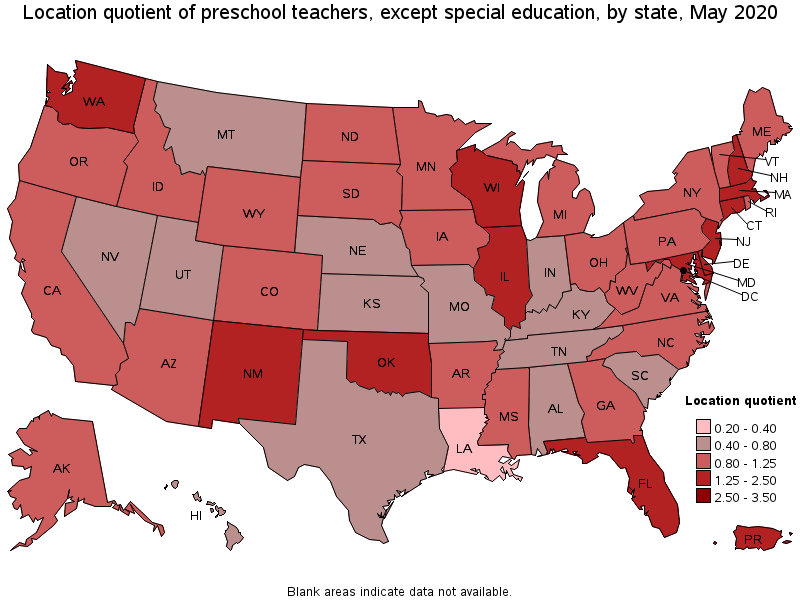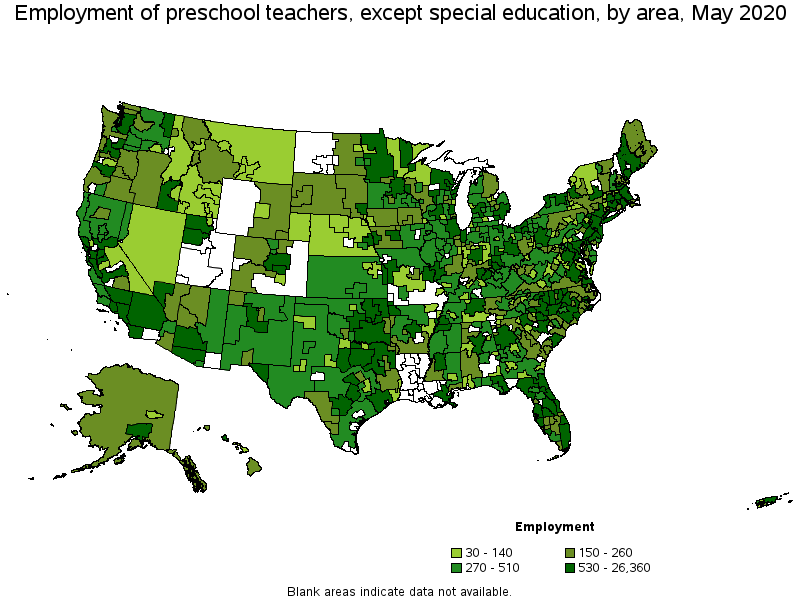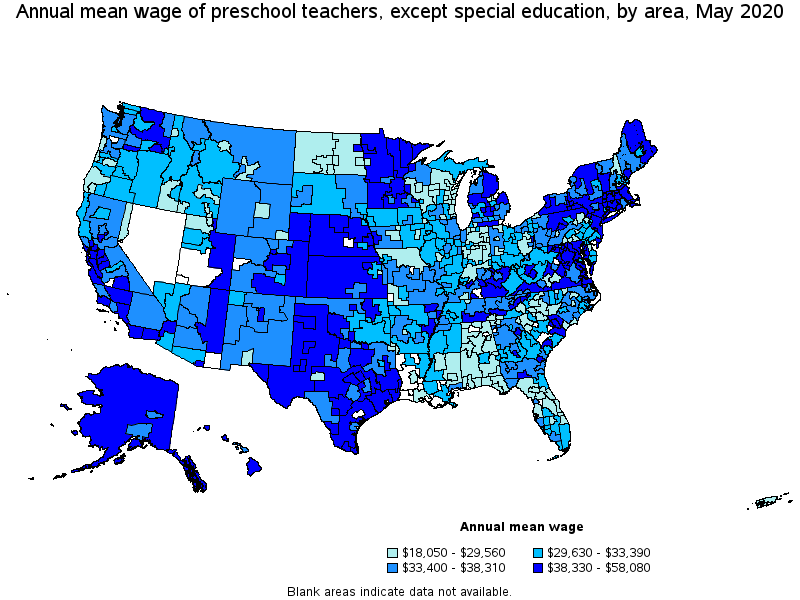An official website of the United States government
 United States Department of Labor
United States Department of Labor
Instruct preschool-aged students, following curricula or lesson plans, in activities designed to promote social, physical, and intellectual growth. Excludes "Special Education Teachers" (25-2050), "Substitute Teachers, Short-Term" (25-3031), and "Childcare Workers" (39-9011).
Employment estimate and mean wage estimates for Preschool Teachers, Except Special Education:
| Employment (1) | Employment RSE (3) |
Mean hourly wage |
Mean annual wage (2) |
Wage RSE (3) |
|---|---|---|---|---|
| 370,940 | 1.4 % | $ 17.57 | $ 36,550 | 0.6 % |
Percentile wage estimates for Preschool Teachers, Except Special Education:
| Percentile | 10% | 25% | 50% (Median) |
75% | 90% |
|---|---|---|---|---|---|
| Hourly Wage | $ 10.53 | $ 12.61 | $ 15.35 | $ 20.36 | $ 28.00 |
| Annual Wage (2) | $ 21,900 | $ 26,220 | $ 31,930 | $ 42,350 | $ 58,230 |
Industries with the highest published employment and wages for Preschool Teachers, Except Special Education are provided. For a list of all industries with employment in Preschool Teachers, Except Special Education, see the Create Customized Tables function.
Industries with the highest levels of employment in Preschool Teachers, Except Special Education:
| Industry | Employment (1) | Percent of industry employment | Hourly mean wage | Annual mean wage (2) |
|---|---|---|---|---|
| Child Day Care Services | 248,180 | 31.33 | $ 15.48 | $ 32,190 |
| Elementary and Secondary Schools | 72,630 | 0.88 | $ 24.29 | $ 50,520 |
| Individual and Family Services | 11,980 | 0.47 | $ 17.72 | $ 36,860 |
| Local Government, excluding schools and hospitals (OEWS Designation) | 8,490 | 0.16 | $ 18.48 | $ 38,450 |
| Religious Organizations | 8,000 | 4.26 | $ 19.12 | $ 39,770 |
Industries with the highest concentration of employment in Preschool Teachers, Except Special Education:
| Industry | Employment (1) | Percent of industry employment | Hourly mean wage | Annual mean wage (2) |
|---|---|---|---|---|
| Child Day Care Services | 248,180 | 31.33 | $ 15.48 | $ 32,190 |
| Religious Organizations | 8,000 | 4.26 | $ 19.12 | $ 39,770 |
| Civic and Social Organizations | 4,940 | 1.73 | $ 17.04 | $ 35,450 |
| Elementary and Secondary Schools | 72,630 | 0.88 | $ 24.29 | $ 50,520 |
| Social Advocacy Organizations | 1,930 | 0.88 | $ 17.86 | $ 37,160 |
Top paying industries for Preschool Teachers, Except Special Education:
| Industry | Employment (1) | Percent of industry employment | Hourly mean wage | Annual mean wage (2) |
|---|---|---|---|---|
| Elementary and Secondary Schools | 72,630 | 0.88 | $ 24.29 | $ 50,520 |
| Business Schools and Computer and Management Training | 60 | 0.09 | $ 22.64 | $ 47,080 |
| Junior Colleges | 1,210 | 0.18 | $ 22.07 | $ 45,910 |
| Colleges, Universities, and Professional Schools | 2,830 | 0.09 | $ 19.91 | $ 41,420 |
| Religious Organizations | 8,000 | 4.26 | $ 19.12 | $ 39,770 |
States and areas with the highest published employment, location quotients, and wages for Preschool Teachers, Except Special Education are provided. For a list of all areas with employment in Preschool Teachers, Except Special Education, see the Create Customized Tables function.

States with the highest employment level in Preschool Teachers, Except Special Education:
| State | Employment (1) | Employment per thousand jobs | Location quotient (9) | Hourly mean wage | Annual mean wage (2) |
|---|---|---|---|---|---|
| California | 46,470 | 2.83 | 1.06 | $ 19.45 | $ 40,450 |
| Florida | 29,290 | 3.47 | 1.30 | $ 14.34 | $ 29,820 |
| Texas | 25,320 | 2.09 | 0.78 | $ 20.03 | $ 41,670 |
| New York | 21,750 | 2.50 | 0.94 | $ 21.52 | $ 44,760 |
| Illinois | 20,110 | 3.57 | 1.34 | $ 16.89 | $ 35,140 |

States with the highest concentration of jobs and location quotients in Preschool Teachers, Except Special Education:
| State | Employment (1) | Employment per thousand jobs | Location quotient (9) | Hourly mean wage | Annual mean wage (2) |
|---|---|---|---|---|---|
| Delaware | 1,920 | 4.50 | 1.69 | $ 14.12 | $ 29,370 |
| New Hampshire | 2,530 | 4.08 | 1.53 | $ 15.78 | $ 32,830 |
| Massachusetts | 13,300 | 3.97 | 1.49 | $ 20.73 | $ 43,120 |
| Oklahoma | 6,080 | 3.89 | 1.46 | $ 16.28 | $ 33,870 |
| Wisconsin | 9,860 | 3.64 | 1.36 | $ 13.90 | $ 28,910 |

Top paying states for Preschool Teachers, Except Special Education:
| State | Employment (1) | Employment per thousand jobs | Location quotient (9) | Hourly mean wage | Annual mean wage (2) |
|---|---|---|---|---|---|
| New Jersey | 13,430 | 3.55 | 1.33 | $ 22.69 | $ 47,190 |
| District of Columbia | 890 | 1.29 | 0.48 | $ 22.06 | $ 45,890 |
| New York | 21,750 | 2.50 | 0.94 | $ 21.52 | $ 44,760 |
| Massachusetts | 13,300 | 3.97 | 1.49 | $ 20.73 | $ 43,120 |
| Maryland | 8,420 | 3.34 | 1.25 | $ 20.51 | $ 42,650 |

Metropolitan areas with the highest employment level in Preschool Teachers, Except Special Education:
| Metropolitan area | Employment (1) | Employment per thousand jobs | Location quotient (9) | Hourly mean wage | Annual mean wage (2) |
|---|---|---|---|---|---|
| New York-Newark-Jersey City, NY-NJ-PA | 26,360 | 2.98 | 1.12 | $ 22.82 | $ 47,460 |
| Chicago-Naperville-Elgin, IL-IN-WI | 15,660 | 3.59 | 1.35 | $ 17.19 | $ 35,760 |
| Los Angeles-Long Beach-Anaheim, CA | 14,260 | 2.45 | 0.92 | $ 19.90 | $ 41,400 |
| Boston-Cambridge-Nashua, MA-NH | 11,220 | 4.31 | 1.62 | $ 20.24 | $ 42,100 |
| Miami-Fort Lauderdale-West Palm Beach, FL | 9,770 | 3.89 | 1.46 | $ 15.03 | $ 31,250 |
| Washington-Arlington-Alexandria, DC-VA-MD-WV | 9,340 | 3.09 | 1.16 | $ 18.83 | $ 39,160 |
| Philadelphia-Camden-Wilmington, PA-NJ-DE-MD | 9,250 | 3.43 | 1.29 | $ 15.88 | $ 33,030 |
| San Francisco-Oakland-Hayward, CA | 9,170 | 3.93 | 1.47 | $ 21.01 | $ 43,700 |
| Dallas-Fort Worth-Arlington, TX | 7,510 | 2.09 | 0.78 | $ 19.50 | $ 40,560 |
| Seattle-Tacoma-Bellevue, WA | 6,850 | 3.50 | 1.31 | $ 17.81 | $ 37,050 |

Metropolitan areas with the highest concentration of jobs and location quotients in Preschool Teachers, Except Special Education:
| Metropolitan area | Employment (1) | Employment per thousand jobs | Location quotient (9) | Hourly mean wage | Annual mean wage (2) |
|---|---|---|---|---|---|
| Homosassa Springs, FL | 220 | 7.36 | 2.76 | $ 18.12 | $ 37,700 |
| Yuba City, CA | 290 | 6.52 | 2.45 | $ 19.60 | $ 40,770 |
| Sebring, FL | 150 | 6.14 | 2.30 | $ 12.48 | $ 25,950 |
| New Bedford, MA | 350 | 5.89 | 2.21 | $ 17.61 | $ 36,620 |
| Bridgeport-Stamford-Norwalk, CT | 2,060 | 5.48 | 2.05 | $ 19.86 | $ 41,300 |
| Manchester, NH | 600 | 5.48 | 2.05 | $ 14.18 | $ 29,500 |
| Duluth, MN-WI | 630 | 5.36 | 2.01 | $ 18.57 | $ 38,620 |
| Dover-Durham, NH-ME | 260 | 5.33 | 2.00 | $ 16.70 | $ 34,740 |
| La Crosse-Onalaska, WI-MN | 380 | 5.33 | 2.00 | $ 15.19 | $ 31,600 |
| Dover, DE | 320 | 5.15 | 1.93 | $ 12.01 | $ 24,970 |

Top paying metropolitan areas for Preschool Teachers, Except Special Education:
| Metropolitan area | Employment (1) | Employment per thousand jobs | Location quotient (9) | Hourly mean wage | Annual mean wage (2) |
|---|---|---|---|---|---|
| Midland, TX | 40 | 0.45 | 0.17 | $ 27.92 | $ 58,080 |
| Odessa, TX | 70 | 0.92 | 0.34 | $ 26.02 | $ 54,120 |
| Hagerstown-Martinsburg, MD-WV | 300 | 3.15 | 1.18 | $ 25.17 | $ 52,350 |
| Springfield, MA-CT | 950 | 3.11 | 1.17 | $ 24.49 | $ 50,940 |
| El Paso, TX | 720 | 2.37 | 0.89 | $ 24.26 | $ 50,470 |
| Longview, TX | 210 | 2.26 | 0.85 | $ 23.97 | $ 49,860 |
| Athens-Clarke County, GA | 300 | 3.53 | 1.33 | $ 23.96 | $ 49,840 |
| Baltimore-Columbia-Towson, MD | 4,030 | 3.13 | 1.17 | $ 23.95 | $ 49,810 |
| San Antonio-New Braunfels, TX | 1,210 | 1.21 | 0.45 | $ 23.70 | $ 49,300 |
| El Centro, CA | (8) | (8) | (8) | $ 23.55 | $ 48,980 |
Nonmetropolitan areas with the highest employment in Preschool Teachers, Except Special Education:
| Nonmetropolitan area | Employment (1) | Employment per thousand jobs | Location quotient (9) | Hourly mean wage | Annual mean wage (2) |
|---|---|---|---|---|---|
| Southeast Coastal North Carolina nonmetropolitan area | 770 | 3.20 | 1.20 | $ 16.26 | $ 33,810 |
| North Florida nonmetropolitan area | 750 | 6.29 | 2.36 | $ 12.48 | $ 25,960 |
| Southwest Maine nonmetropolitan area | 690 | 3.80 | 1.42 | $ 18.17 | $ 37,800 |
| Northeast Oklahoma nonmetropolitan area | 690 | 5.98 | 2.24 | $ 14.30 | $ 29,740 |
| Southeast Oklahoma nonmetropolitan area | 640 | 3.87 | 1.45 | $ 15.61 | $ 32,470 |
Nonmetropolitan areas with the highest concentration of jobs and location quotients in Preschool Teachers, Except Special Education:
| Nonmetropolitan area | Employment (1) | Employment per thousand jobs | Location quotient (9) | Hourly mean wage | Annual mean wage (2) |
|---|---|---|---|---|---|
| North Florida nonmetropolitan area | 750 | 6.29 | 2.36 | $ 12.48 | $ 25,960 |
| Northeast Oklahoma nonmetropolitan area | 690 | 5.98 | 2.24 | $ 14.30 | $ 29,740 |
| Northwest Oklahoma nonmetropolitan area | 470 | 5.06 | 1.90 | $ 16.44 | $ 34,190 |
| Southwest Oklahoma nonmetropolitan area | 290 | 4.90 | 1.84 | $ 20.67 | $ 42,980 |
| West Arkansas nonmetropolitan area | 400 | 4.66 | 1.75 | $ 16.65 | $ 34,620 |
Top paying nonmetropolitan areas for Preschool Teachers, Except Special Education:
| Nonmetropolitan area | Employment (1) | Employment per thousand jobs | Location quotient (9) | Hourly mean wage | Annual mean wage (2) |
|---|---|---|---|---|---|
| Capital/Northern New York nonmetropolitan area | 130 | 1.00 | 0.37 | $ 26.47 | $ 55,060 |
| South Nebraska nonmetropolitan area | 110 | 0.78 | 0.29 | $ 24.50 | $ 50,970 |
| South Central Tennessee nonmetropolitan area | 110 | 1.08 | 0.40 | $ 23.53 | $ 48,950 |
| Southwest Virginia nonmetropolitan area | 220 | 1.84 | 0.69 | $ 23.52 | $ 48,910 |
| Northeast Minnesota nonmetropolitan area | 90 | 2.20 | 0.83 | $ 23.43 | $ 48,730 |
These estimates are calculated with data collected from employers in all industry sectors, all metropolitan and nonmetropolitan areas, and all states and the District of Columbia. The top employment and wage figures are provided above. The complete list is available in the downloadable XLS files.
The percentile wage estimate is the value of a wage below which a certain percent of workers fall. The median wage is the 50th percentile wage estimate—50 percent of workers earn less than the median and 50 percent of workers earn more than the median. More about percentile wages.
(1) Estimates for detailed occupations do not sum to the totals because the totals include occupations not shown separately. Estimates do not include self-employed workers.
(2) Annual wages have been calculated by multiplying the hourly mean wage by a "year-round, full-time" hours figure of 2,080 hours; for those occupations where there is not an hourly wage published, the annual wage has been directly calculated from the reported survey data.
(3) The relative standard error (RSE) is a measure of the reliability of a survey statistic. The smaller the relative standard error, the more precise the estimate.
(8) Estimate not released.
(9) The location quotient is the ratio of the area concentration of occupational employment to the national average concentration. A location quotient greater than one indicates the occupation has a higher share of employment than average, and a location quotient less than one indicates the occupation is less prevalent in the area than average.
Other OEWS estimates and related information:
May 2020 National Occupational Employment and Wage Estimates
May 2020 State Occupational Employment and Wage Estimates
May 2020 Metropolitan and Nonmetropolitan Area Occupational Employment and Wage Estimates
May 2020 National Industry-Specific Occupational Employment and Wage Estimates
Last Modified Date: March 31, 2021